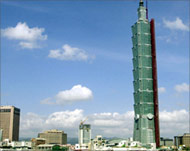Geologist blames tower for quakes
A geologist says seismic activity in Taipei has increased since the world’s tallest building, Taipei 101, was built.

Lin Cheng-horng, a geologist at the Institute of Earth Sciences at the Academia Sinica, Taiwan‘s most prestigious think-tank, said seismic activity historically had been low in the Taipei basin, where about seven million people live.
But the city has experienced more micro-earthquakes (of magnitude 2.0-2.5 on the Richter scale) since construction began on the 508-metre skyscraper in 1997, he said.
Two earthquakes of magnitude 3.8 and 3.2 occurred directly beneath Taipei 101 in October 2004 and March 2005.
“There is a distinct possibility of earthquakes being triggered by the recent construction of the world’s highest building, the imposing Taipei 101,” Lin stated in an article published in the Geophysical Research Letters Volume 32 on 30 November.
“Should seismic activity remain high or, even worse, should it significantly increase, then the possibility of earthquakes being triggered by the highrise building will become ever so much more of a reality.”
Geological standards
Michael Liu, the Taipei 101 spokesman, said he respected the academic’s views, but pointed out that the 101-storey building was a government-endorsed project that had met environmental and geological standards set by the Taiwan government.
 |
|
Taipei 101 weighs 700,000 tonnes |
Earthquakes occur frequently in Taiwan, which lies on a seismically active stretch of the Pacific basin, but Taipei itself has suffered minimal tremors in the past as it lies over the western boundary of the Philippine Sea plate.
An earthquake is caused by a sudden slip on a fault in the earth’s crust. Stresses in the earth’s outer layer push the sides of the fault together until rocks slip suddenly, releasing energy in waves that cause the ground to shake.
Lin said Taipei 101 weighed 700,000 tonnes and estimated stress from vertical loading on its foundation at 4.7 bars, of which some would be transferred to the earth’s upper crust because of extremely soft sedimentary rocks beneath the Taipei basin.
Lin said: “If a fault is about to crack, then a little pressure can trigger an earthquake. It’s like the last straw that breaks the camel’s back.”
Theory
But that is only a theory, Lin said, adding that he could not determine whether or not Taipei 101 was responsible for the rise in seismic activity in the area in recent years.
He said: “I don’t know if it’s just coincidence or if they are related. It’s very hard to prove this scientifically, but it’s just as hard to disprove it.”
|
“I don’t know if it’s just coincidence or if they are related. It’s very hard to prove this scientifically, but it’s just as hard to disprove it” Lin Cheng-horng, |
Lin is therefore calling for immediate research into the issue, saying it could have far-reaching implications for other huge structures, such as the proposed 1000-metre Sky City 1000 in Japan, another quake-prone area.
Earthquakes induced by human activity, such as water dams, have been documented in the United States, Japan, and Canada. But Lin said there were no specific studies into whether high-rise buildings could cause tremors.
He suggested that Taiwan install more accurate sensors to monitor tremors – most of Taiwan‘s sensors are above ground, unlike Japan, which has more than 1000 buried at depths of hundreds of metres.
The $1.7 billion Taipei 101, an office tower and shopping complex, was built to withstand tremors measuring above magnitude seven and resist gale forces of more than 60 metres a second.